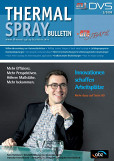Arc-sprayed iron-based alloys for corrosionprotection in waste incineration plants
Authors: Prof. Dr.-Ing. habil. Johannes Wilden, Dipl.-Ing. Viktor Drescher, Prof. Dr.-Ing. Michael Schütze, Dr. Rick Durham
Metallic components in waste incineration plants, e.g. heat exchangers, are exposed to a highly corrosive atmosphere. Gases with particularly high chlorine contents lead to the very quick wear of the base material. In this reaction designated as active oxidation, the chlorine merely serves as a catalyst: In this respect, chlorine diffuses through the oxide coat as far as the metallic boundary surface where it forms volatile iron chlorides which are subsequently oxidised on the surface again. Thereafter, the released chlorine is available for the reaction once more. In order to prevent any excessive material wear, anti-corrosion coats, as a rule on a nickel basis, are applied today. Recent research activities prove that the corrosion resistance of iron-chromium compounds can be increased substantially by adding silicon and, in part, even considerably exceeds that of the normally utilised nickel-based alloys. In order to verify the potential of these materials, flux-cored wires with different compositions were manufactured and were applied by means of arc spraying. Subsequently, corrosion investigations were conducted on the specimens in an atmosphere containing chlorine.
Pages: 141 - 146






Order this article as a PDF for 8.00 Euro. Send us a short e-mail with your details.
An active subscription enables you to download articles or entire issues as PDF-files. If you already are a subscriber, please login. More information about the subscription








